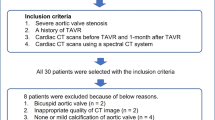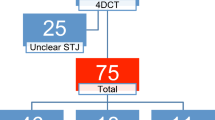Abstract
Purpose
This study was done to investigate the dynamic changes of the aortic root during systole and diastole in patients with coronary artery calcification (CAC) using dual-source computed tomography (DSCT).
Materials and methods
We retrospectively analysed 77 consecutive patients who underwent calcium-scoring and angiographic cardiac DSCT. The long- and short-axis dimensions, axis areas of the aortic annulus, sinotubular junction and ascending aorta at the level of the pulmonary trunk in diastole and systole were measured. Average dimensions and relative areal changes between diastole and systole (%RA) of aortic annulus, sinotubular junction and ascending aorta were compared.
Results
Systolic and diastolic long- and short-axis dimensions of the aortic annulus in patients with CAC (n = 44) demonstrated statistically significant differences (27.00 ± 2.84 mm vs. 28.04 ± 2.62 mm; P < 0.001; 21.78 ± 2.55 mm vs. 20.88 ± 2.31 mm; P < 0.001), while differences in average diameters and areas of the aortic annulus were nonsignificant (P > 0.586). Systolic and diastolic axial areas of the sinotubular junction in patients with CAC demonstrated significant differences (7.21 ± 1.80 cm2 vs. 6.92 ± 1.75 cm2; P < 0.001). The %RA of the ascending aorta in patients with severe CAC (CAC score >400; n = 15) was significantly reduced compared to patients with minimal-to-moderate CAC (CAC score <400; n = 29; 4.77 ± 2.88 vs. 7.51 ± 3.81, P = 0.014).
Conclusions
In comparison with patients without CAC, the long- and short-axis dimensions of the aortic annulus and areas of the sinotubular junction show significant differences during the cardiac cycle in patients with CAC. The presence of severe CAC significantly influences the flexibility of the wall of the ascending aorta.



Similar content being viewed by others
References
Lam CS, Gona P, Larson MG et al (2013) Aortic root remodeling and risk of heart failure in the Framingham Heart study. JACC Heart Fail 1(1):79–83
Gardin JM, Arnold AM, Polak J (2006) Usefulness of aortic root dimension in persons > or = 65 years of age in predicting heart failure, stroke, cardiovascular mortality, all-cause mortality and acute myocardial infarction (from the Cardiovascular Health Study). Am J Cardiol 97(2):270–275
Marom G, Haj-Ali R, Rosenfeld M et al (2013) Aortic root numeric model: annulus diameter prediction of effective height and coaptation in post-aortic valve repair. J Thorac Cardiovasc Surg 145(2):406–411.e1
Zhu D, Zhao Q (2011) Dynamic normal aortic root diameters: implications for aortic root reconstruction. Ann Thorac Surg 91(2):485–489
Losenno KL, Gelinas JJ, Johnson M, Chu MWA (2013) Defining the efficacy of aortic root enlargement procedures: a comparative analysis of surgical techniques. Can J Cardiol 29(4):434–440
Tops LF, Wood DA, Delgado V et al (2008) Noninvasive evaluation of the aortic root with multislice computed tomography implications for transcatheter aortic valve replacement. JACC Cardiovasc Imaging 1(3):321–330
Wood DA, Tops LF, Mayo JR et al (2009) Role of multislice computed tomography in transcatheter aortic valve replacement. Am J Cardiol 103(9):1295–1301
Kazui T, Izumoto H, Yoshioka K, Kawazoe K (2006) Dynamic morphologic changes in the normal aortic annulus during systole and diastole. J Heart Valve Dis 15(5):617–621
De Heer LM, Budde RPJ, Mali WPTM et al (2011) Aortic root dimension changes during systole and diastole: evaluation with ECG-gated multidetector row computed tomography. Int J Cardiovasc Imaging 27(8):1195–1204
Bertaso AG, Wong DT, Liew GY et al (2012) Aortic annulus dimension assessment by computed tomography for transcatheter aortic valve implantation: differences between systole and diastole. Int J Cardiovasc Imaging 28(8):2091–2098
O’Rourke RA, Brundage BH, Froelicher VF et al (2000) American College of Cardiology/American Heart Association Expert Consensus Document on electron-beam computed tomography for the diagnosis and prognosis of coronary artery disease. J Am Coll Cardiol 36(1):326–340
Vriz O, Driussi C, Bettio M et al (2013) Aortic root dimensions and stiffness in healthy subjects. Am J Cardiol 112(8):1224–1229
Li N, Beck T, Chen J et al (2011) Assessment of thoracic aortic elasticity: a preliminary study using electrocardiographically gated dual-source CT. Eur Radiol 21(7):1564–1572
Gurvitch R, Webb JG, Yuan R et al (2011) Aortic annulus diameter determination by multidetector computed tomography: reproducibility, applicability, and implications for transcatheter aortic valve implantation. JACC Cardiovasc Interv 4(11):1235–1245
Schuhbaeck A, Achenbach S, Pflederer T et al (2014) Reproducibility of aortic annulus measurements by computed tomography. Eur Radiol 24(8):1878–1888
Nelson AJ, Worthley SG, Cameron JD et al (2009) Cardiovascular magnetic resonance-derived aortic distensibility: validation and observed regional differences in the elderly. J Hypertens 27(3):535–542
Cavalcante JL, Lima JAC, Redheuil A, Al-Mallah MH (2011) Aortic stiffness: current understanding and future directions. J Am Coll Cardiol 57(14):1511–1522
Ahmadi N, Nabavi V, Hajsadeghi F et al (2011) Impaired aortic distensibility measured by computed tomography is associated with the severity of coronary artery disease. Int J Cardiovasc Imaging 27(3):459–469
Ahmadi N, Hajsadeghi F, Gul K et al (2008) Relations between digital thermal monitoring of vascular function, the Framingham risk score, and coronary artery calcium score. J Cardiovasc Comput Tomogr 2(6):382–388
Son MK, Chang SA, Kwak JH et al (2013) Comparative measurement of aortic root by transthoracic echocardiography in normal Korean population based on two different guidelines. Cardiovasc Ultrasound 11:28
Sieslack AK, Dziallas P, Nolte I, Wefstaedt P (2013) Comparative assessment of left ventricular function variables determined via cardiac computed tomography and cardiac magnetic resonance imaging in dogs. Am J Vet Res 74(7):990–998
Raman SV, Shah M, McCarthy B et al (2006) Multi-detector row cardiac computed tomography accurately quantifies right and left ventricular size and function compared with cardiac magnetic resonance. Am Heart J 151(3):736–744
Takx RA, Moscariello A, Schoepf UJ et al (2012) Quantification of left and right ventricular function and myocardial mass: comparison of low-radiation dose 2nd generation dual-source CT and cardiac MRI. Eur J Radiol 81(4):e598–e604
Conflict of interest and source of funding
No funding was received. Ralf W. Bauer and J. Matthias Kerl are on the speaker’s bureau of Siemens Healthcare, Computed Tomography division. All other authors have no conflicts of interest. Furthermore, all data in this study was controlled by authors with no conflicts of interest.
Author information
Authors and Affiliations
Corresponding author
Rights and permissions
About this article
Cite this article
Hu, X., Frellesen, C., Bauer, R.W. et al. Computed tomography of dynamic changes of the aortic root during systole and diastole in patients with coronary artery calcification. Radiol med 120, 595–602 (2015). https://doi.org/10.1007/s11547-015-0503-7
Received:
Accepted:
Published:
Issue Date:
DOI: https://doi.org/10.1007/s11547-015-0503-7




